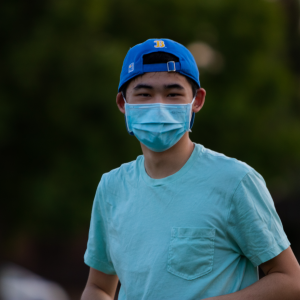



The debate over whether SROs should remain on school campuses is multi-faceted, with various stakeholders weighing in on the issue.
November 9, 2020
On July 29th, the Fremont Unified School District Board of Education voted to suspend the Student Resource Officer (SRO) program after the pandemic rendered all campuses closed. Along with the suspension was a proposal to form a Task Force consisting of various FUSD stakeholders to review the efficacy of the program. After four meetings, the Task Force issued its Final Report on Oct. 29th advocating the removal of SROs from all FUSD campuses.
SROs are part of a special division of the Fremont Police Department that oversee security on school campuses. Officers must undergo a test and interview conducted by the Fremont Police Department before they are approved to becoming a School Resource Officer. They have a three-year commitment to the school they are assigned, with an optional extension of two years. The six SROs rotate out of their schools at different times.
Ultimately, the Final Report found the SRO program to have, “no measurable goals, no assessment of student outcomes, a complete lack of policies to guide administrators (i.e., unfettered discretion), a practice of using law enforcement for routine school discipline matters under the guise of counseling, no training of administrative staff on protecting students’ rights, no data archived by the District to evaluate the program; and inadequate oversight or control by the District.”
The Task Force recommended the following main actions:
The report references numerous studies that show “Increased police‐student contact at schools has a disproportionately negative impact on low‐income students, students of color, and students with disabilities. Black students are three times as likely as white students to be subjected to school‐related arrest and students with disabilities are three times as likely as students without disabilities to be arrested. Studies also show that safety measures such as a police presence on campus make students more fearful and less trusting of school officials and police.” It remains difficult, however, to apply the same national statistics to a unique community like Fremont specifically.
of students reported no interactions with SROs.

The report cites a survey conducted by FUSD, wherein “on a scale of 1-5, SROs made students feel safe with an average of 3.81. On average, students have felt supported 1.12 times by an SRO. Approximately 77.9% of students reported no interactions with SROs.” The Fremont Police Department does not require SROs to document all student interactions because of their subjective nature, thus only arrests are shown.
Proponents of the SRO program believe that the benefits provided by having an SRO on campus may be hard to replace.
“I just know that I’ve been actually doing this for a very long time,” said Officer Joel Luevano, Irvington’s SRO. “And for some of the things that I deal with on campus, I am able to draw from my experiences, and not so much from what I’ve actually studied [academically]. I’ve never got anything but positive feedback. So to me, it’s very baffling and shocking that this [cancellation of SROs] would occur.”
“I’ve never got anything but positive feedback. So to me, it’s very baffling and shocking that this [cancellation of SROs] would occur.”
Officer Joel Luevano
Specifically, Irvington High School’s administration has had a positive relationship with Officer Luevano and his work with students.
“He tries to get to know as many students as possible, he often participates in QUEST as a consultant,” said Irvington Principal Amanda Melsby. “So I think he works very hard to be a part of the school community. If there are things that arise that need his help, there’s already a relationship established.”
Examples of such interactions with students detail the extent of an impact an SRO can have on students. Officer Luevano told The IHS Voice of one of many examples where a student was left at home with their younger siblings and elderly relative for an extended period of time and had a diminishing supply of food. After realizing this, he was able to buy groceries for the student and offered to help them out whenever necessary. Many other struggling students have appreciated the early interventions SROs provide, stating it has set them in the right direction. While stories like this may be extraordinary, Officer Luevano’s rapport with students continues to remain positive and exemplifies how far an SRO can go to help students in need.
It is important to note, however, that negative interactions with SROs also exist. Due to lack of oversight by the District on the SRO program, there have been instances when SROs exhibited inappropriate behavior. One anecdotal account from an alumna of the Class of 2014 described her encounter with an SRO who entered her home and took her to a mental health institution against the advice of her mental health therapist. She states that the SRO also made racial comments about her family and that the officer was not adequately equipped to deal with students with mental health issues.
In mid-October, FUDTA held a forum that evaluated and approved the elimination of the SRO program across all FUSD schools. They recommend healthcare providers and social workers be responsible for the roles of support for students in crisis and vaping presentations, which are currently done by SROs. FUDTA would still like to receive continued support from FPD on “security for sporting events, dances, and graduations; class presentations; and run, hide, fight training.”
That FUDTA Resolution calls for redirecting resources and school disciplinary measures. Similar to the Task Force Report, FUDTA also found that SRO arrests are racially disproportionate (Latinx students were 4.1x as likely as Asian students to get suspended, and 7x as likely as Asian students to get suspended for “defiance” in the 2018-2019 school year) and the annual $830,000 that the SRO program costs FUSD will only burden the budget cuts that are yet to come.
Latinx students are 4.1 times as likely as Asian students to be suspended in FUSD.
Yearly cost of the SRO program to FUSD.
The suspension statistics above are based on suspension rate by race/ethnicity. The raw numbers of Asian and Latinx students suspended in the 2018-2019 year are 188 Asian and 179 Latinx. For full data, click here.
There are several reasons driving FUDTA’s decision in their final Resolution to be presented to the Board of Education.
“We need a social worker, we need a psychologist for every single high school way more than we need an SRO right now.”
Ms. Shiloh Burton
“First, we’re not on campus, so we don’t need them right now,” said Ms. Shiloh Burton, a photography teacher at Irvington. “Secondly, mental health issues are way more important, given the current context. We need a social worker, we need a psychologist for every single high school way more than we need an SRO right now. And then lastly, the question you should be asking is why our school districts are paying for the police department to show up when it’s their job, and they get one-third of every month’s budget as a city?”
FUDTA also notes SROs may not really increase school safety or prevent incidents. The National Association of School Resource Officers cites only “one study that showed positive outcomes for schools with SRO programs.” That study was conducted in Canada, not the United States.
Although the FUDTA resolution advocates for hiring extra social workers and healthcare providers, there are also many SRO roles that those professions cannot cover. SROs remain a presence on campus to deter crime and offer faster response time than traditional police officers when such illegal activity occurs.
“We’re very lucky that threats, intruders, those types of things don’t happen very often, but there’s always the concern that it could at any moment.” said Ms. Melsby. “And so having as short of a response time as possible is the optimal.”
At Irvington, quick response time has also made Officer Luevano an asset to Special Education students (contrary to the Task Force claim that Special Education students are specifically targeted), checking in with their mental health and helping families in need.
“I’ve had some kids that I’ve been really worried about,” said Mrs. Raine Stilwell, a Special Education teacher at Irvington. “If I went to Officer Luevano, and said could possibly just swing by their house and check and make sure they’re okay. He would do it the minute he had a free minute to go do it. If I tried to get the district to go out there, it would take weeks.”
Impending budget cuts also raise concerns that any new social or mental health workers will be the first in line to be removed, creating a void where SROs used to be.
With information mounting on both sides of the debate, the Board of Education is expected to make a reevaluation of the program at the Nov. 12th FUSD Board meeting. The meeting will be livestreamed here.
To access the meeting agenda, click here.
To access the Task Force’s Final Report, click here.
To access the Task Force’s resources and materials, click here.
For more information about the SRO task force, read one of our past articles here.
Additional Information:
Approved by the Fremont Board of Education on Aug. 12th, the SRO Task Force was created with 2 CSEA members (California School Employees Association), 2 FSMA members (Fremont School Management Association), 2 FUDTA members (Fremont Unified District Teachers Association), 2 SEIU members (Service Employees International Union), 6 student members (chosen by SURFBoardE), 6 parent members (chosen by Board Trustees), 5 community members (chosen by Board Trustees), and 2 board members (chosen by Board Trustees).



